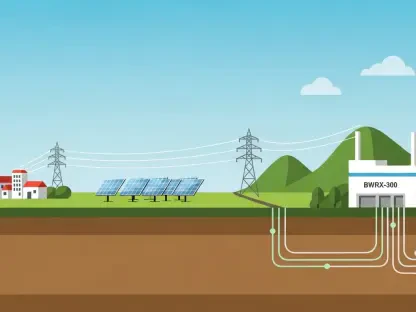Setting the Stage for a Critical Market Shift
Imagine a global energy giant, long dominant in oil markets, now grappling with a perfect storm of geopolitical strife and economic constraints that threaten its standing. Russia’s oil export revenues have stumbled, slipping from $13.58 billion in August to $13.35 billion in September, as reported by the International Energy Agency (IEA). This decline, though seemingly modest, signals deeper vulnerabilities in a sector that underpins the nation’s economy. With Western sanctions tightening, Ukrainian drone attacks disrupting infrastructure, and market dynamics shifting unfavorably, the stakes for Russia’s energy industry have never been higher.
This market analysis aims to dissect the forces behind this revenue dip, offering a lens into the intricate balance of crude oil gains, refined product losses, and operational setbacks. The purpose is to provide stakeholders with actionable insights into current trends and future projections for one of the world’s largest energy producers. By exploring data-driven patterns and external pressures, this examination seeks to illuminate the path ahead for a sector at a critical juncture, urging industry players to adapt to an increasingly volatile landscape.
Unpacking the Market Trends and Data
Crude Oil Surge Amid Refined Product Slump
A closer look at Russia’s oil export figures reveals a tale of two contrasting trends. Crude oil exports climbed to an impressive 5.1 million barrels per day (bpd) in September, marking the highest level in over two years. This spike, fueled by diminished domestic refining capacity, allowed an additional $200 million in earnings as more barrels flowed to international markets. However, this gain was overshadowed by a steep drop in refined product exports, which fell to 2.4 million bpd—the lowest since early 2020, outside pandemic disruptions. The decline, particularly in gasoil and fuel oil shipments, led to a substantial $440 million loss, underscoring a critical imbalance in the revenue stream.
This disparity highlights a structural challenge within the market. While raw crude can be redirected to buyers in regions like Asia, the inability to process oil into higher-value products limits profitability. Countries such as Saudi Arabia, once key recipients of refined fuels, have seen reduced imports, further straining earnings. For market observers, this trend suggests that short-term crude export boosts may not sustain long-term financial health without addressing refining bottlenecks.
Infrastructure Disruptions and Operational Headwinds
Beyond export imbalances, physical disruptions pose a severe threat to market stability. Ukrainian drone strikes have targeted key energy infrastructure, slashing Russia’s crude processing capacity by an estimated 500,000 bpd, with an additional 200,000 bpd lost in September alone. Refineries and storage depots, critical to maintaining supply chains, have borne the brunt of these attacks, leading to domestic fuel shortages and curtailed export capabilities. The cascading effect is evident in both local market strain and diminished international shipments.
The financial toll of these disruptions extends beyond immediate losses. Repair costs and operational delays compound the economic burden, diverting resources from potential growth initiatives. For global energy markets, this situation raises concerns about supply reliability from a major producer, potentially pushing buyers to seek alternative sources. The ongoing conflict shows no sign of resolution, indicating that such operational challenges could persist, further eroding Russia’s competitive edge.
Market Oversupply and Pricing Pressures
Adding to the complexity are unfavorable market dynamics that continue to squeeze profit margins. The discount on Urals crude, Russia’s benchmark grade, widened to over $13 per barrel against the North Sea standard in early October. This reflects a global market grappling with oversupply, where surplus Russian barrels struggle to find willing buyers under the weight of sanctions. Even as production edged up by 170,000 bpd to 9.21 million bpd in September, it remained below the OPEC+ quota of 9.415 million bpd, signaling constrained output amid external pressures.
Non-Western markets like China and India have absorbed some of this excess at discounted rates, but the lower prices inevitably cut into revenue. This pricing challenge, coupled with geopolitical barriers, paints a sobering picture of an industry caught between supply-side disruptions and demand-side limitations. For analysts, the widening discount serves as a stark reminder of how international isolation translates into tangible economic penalties, reshaping Russia’s market position.
Forecasting the Path Ahead
Persistent Threats and Strategic Adaptations
Looking toward the future, Russia’s energy market faces a landscape rife with uncertainty. The ongoing military conflict suggests that infrastructure damage from drone attacks will likely continue, further hampering refining capacity and export potential. Western sanctions, already a formidable barrier, may tighten further, with the potential for stricter enforcement of price caps and penalties on non-compliant buyers. Technological limitations, driven by restricted access to advanced equipment and expertise, could also stall recovery efforts, forcing reliance on outdated systems or costly alternatives.
Despite these headwinds, certain adaptive strategies may emerge. Redirecting crude oil to friendly markets, even at reduced prices, could provide a temporary lifeline for cash flow. There is also speculation about investments in alternative refining solutions or deeper partnerships with non-Western allies for technical support. However, without significant policy shifts or conflict de-escalation, revenue challenges are projected to linger into the coming years, potentially diminishing Russia’s influence in global energy trade.
Broader Implications for Energy Markets
The ripple effects of Russia’s struggles extend far beyond its borders, influencing global energy dynamics. A sustained decline in refined product exports could tighten supply in specific regions, prompting price volatility for fuels like gasoil. Simultaneously, the push to redirect crude oil may intensify competition in oversupplied markets, further depressing prices. For energy importers, this scenario underscores the risk of over-reliance on a single supplier amid geopolitical instability, urging a reevaluation of sourcing strategies.
Projections indicate that if current trends hold, Russia’s market share could contract, creating opportunities for other producers to fill the gap. OPEC+ dynamics may also shift as members adjust quotas to balance supply. Stakeholders must monitor these developments closely, as the interplay of conflict, sanctions, and market forces will likely redefine energy trade patterns in the near term, with lasting consequences for pricing and availability.
Reflecting on a Sector in Transition
Looking back, the analysis of Russia’s oil market paints a complex picture of declining revenues and mounting challenges that unfolded in September. The $230 million drop, driven by a sharp fall in refined product earnings, stands as a testament to systemic issues—ranging from infrastructure damage to market oversupply—that erode financial stability. The surge in crude exports offered a fleeting buffer, yet failed to counterbalance the deeper vulnerabilities exposed by geopolitical and operational setbacks.
For stakeholders, the next steps involve strategic diversification to mitigate risks tied to supply interruptions and price fluctuations. Exploring alternative energy suppliers or investing in regional stockpiles emerges as a prudent measure to safeguard against uncertainty. Additionally, staying attuned to evolving sanction policies and conflict updates proves essential for navigating this turbulent market. These actions, grounded in the lessons of recent trends, provide a roadmap for adapting to a shifting energy landscape while seizing potential opportunities amid the upheaval.









